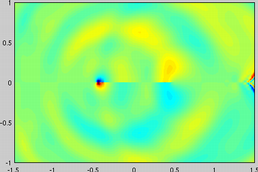Stochastic computational methods for aero-acoustics
- Research Team
- Martina Dieste
- Investigators
- Gwenael Gabard
Sound can be efficiently generated when turbulent flows interact with solid boundaries. This is the case in aircraft engines where turbulent wakes from fan blades impinge on guide vanes. Modelling these problems with computational methods can be challenging because one has to resolve both the turbulent field and the acoustic waves. For engineering purposes the turbulent flow can be synthesized rather than fully resolved from the Navier-Stokes equations. This involves producing a random velocity field that satisfies some prescribed statistical properties such as the energy spectrum, correlation, etc...
In this project, a random particle method was developed and coupled with a finite difference solver for the linearized Euler equations to predict broadband interaction noise. The use of a particle-based method instead of a Fourier mode approach (such as the SNGR model) offers a way to represent non-uniform turbulent field more easily.
Categories
Physical Systems and Engineering simulation: Acoustics, CFD
Algorithms and computational methods: Finite differences, Meshless methods
Software Engineering Tools: SVN
Programming languages and libraries: C++, Matlab, MPI
Computational platforms: Linux
